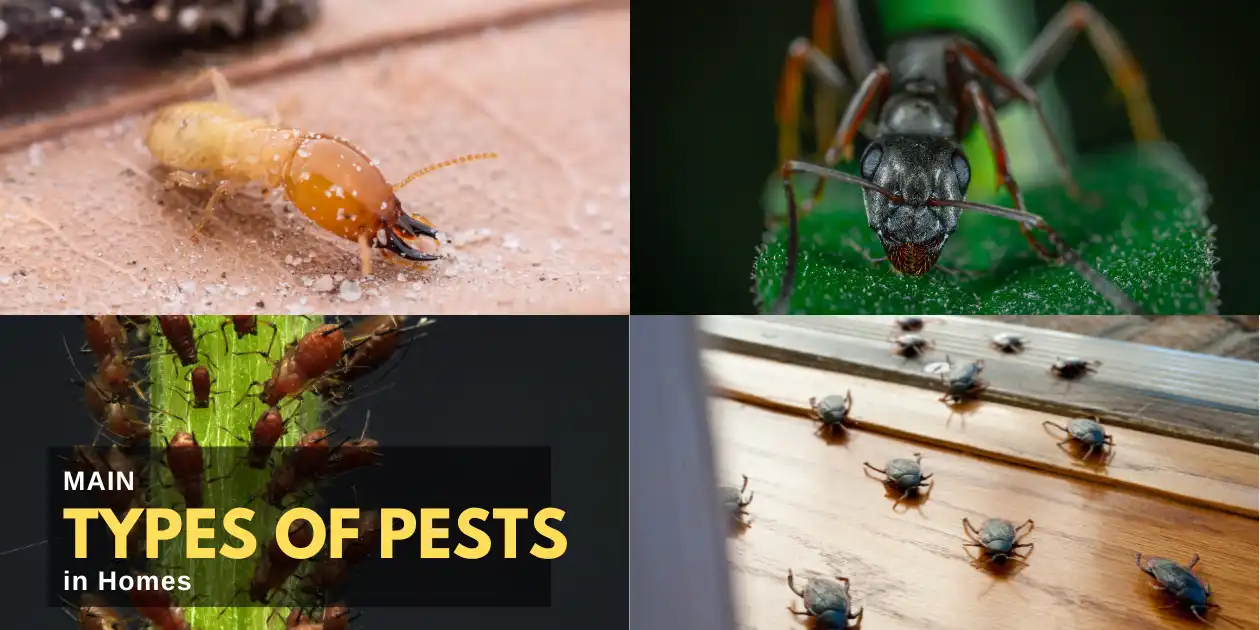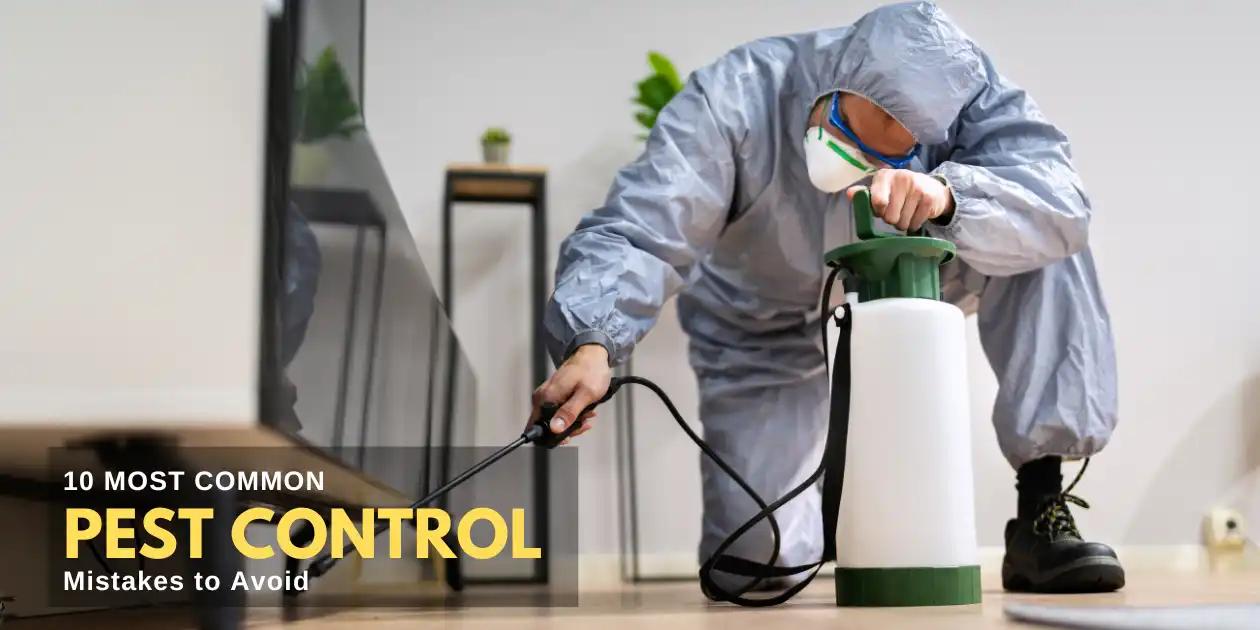Eliminating insects can be an essential aspect to keep your home in good shape, but regardless of how careful homeowners might be, they’re susceptible to errors that could result in more pests, or put themselves at risk of from medical risks. Understanding the most common pest control mistakes, and the best ways to avoid them can help you ensure that your home remains secure, healthy and free of any pests throughout the season. This complete guide will provide the most often committed pest control mistakes and the negative consequences they have. Simple to follow strategies for homeowners of all ages.
What Are the Main Types of Pests in Homes?

In order to be sure you are not prone to mistakes, you should keep an eye on the frequently seen home insect
- Ants: They are attracted by water and food especially in kitchens and bathrooms.
- Cockroaches: thrive in warm, humid conditions and are able to spread diseases.
- Rodents (mice and rats): Seek shelter warmth and food.
- Termites: They cause structural damage through their gnawing upon wooden buildings.
- Spiders: They’re generally secure, but they can cause problems.
- Bedbugs: Infest furniture, bedding, and can cause painful bites that cause itching.
- The fleas as well as ticks: Infect pets and can be transferred to humans.
- Wasps, bees, along with other insect species: Build nests in attics and eaves and also inside the yards.
Cost of Pest Control by Pests Type
| Pest Type | DIY Treatment Cost | Professional Treatment Cost |
| Ants | 10-10-50 | 100-100-300 |
| Cockroaches | 20-20-80 | 150-150-400 |
| Rodents | 15-15-60 | 150-150-500 |
| Termites | 30-30-150 | 1,000-1,000-4,000+ |
| Bed Bugs | 30-30-100 | 500-500-2,500+ |
| Fleas/Ticks | 20-20-80 | 100-100-300 |
| Wasps/Bees | 15-15-60 | 100-100-400 |
DIY costs could include sprays, traps and numerous other items. Professional prices differ based on the location in the region and the size of.
Cost of Pest Control by Home Size
| Home Size | DIY Treatment Cost | Professional Treatment Cost |
| Apartment/Condo | 20-20-80 | 80-80-200 |
| “The Home” of The Small House (<1,500 sq feet) | 30-30-100 | 120-120-250 |
| Medium Home (1,500-2,500 sq ft) | 50-50-150 | 200-200-400 |
| Large Home (>2,500 sq ft) | 80-80-200 | 300-300-600 |
The houses with greater dimensions and are more prone to infestations could cost more.
Factors Influencing Pest Control Costs and Effectiveness
- The Nature of the Severity: Infestation Pests with multiple problems are more costly to manage.
- Dimensions of Layout and Home: Homes that are bigger require more work and building materials.
- Location: Rural and urban influence the pest species and their cost.
- Recurring Maintenance: The maintenance on a regular schedule is cheaper than emergency treatment.
- DIY vs Professionals: DIY is more affordable, however it’s not as effective for serious infestations.
- Secure Measures :A good prevention plan at home will need less effort.
Security Features: How to Pest Proof Your Home
- Fill in gaps and cracks between doors, windows, and the at the base in the construction.
- installation of door sweepers and screens for repair.
- Weatherstripping to block access points.
- items that contain food items are placed in airtight bags and then sealed with trash.
- Fix the leakage and stop stagnation in the water pool.
- Cut the plant out of your property.
- Make an enclosure of mesh to protect chimneys and vents.
Step by Step Guide: 10 Most Common Pest Control Mistakes to Avoid

1. Ignoring Early Signs of Infestation
Mistake:
It’s recommended that you wait till the bugs are all over before you decide to do anything.
Solution:
Be alert when you notice signs of chewed wires or droppings. Bugs could signal the presence of a bigger problem.
2. Relying Only on DIY Solutions
Mistake:
Make every effort to rid yourself of huge infestations by spraying traps or stores.
Solution:
DIY can be a wonderful option for those with minor problems. But, it is recommended to seek advice from an expert in case of ongoing or major problems.
3. Not Addressing the Source of the Problem
Mistake:
Removal of visible insects but, we must not forget nests entrance points, as well as food sources.
Solution:
Find and eliminate the root of the issue. Secure access points, fix leaks, and then take out food and other sources.
4. Skipping Regular Inspections
Mistake:
Based on the belief that your home isn’t contaminated by insects and you haven’t conducted any research.
Solution:
Make sure to look over your home regularly particularly in basements, attics, as well as crawlspaces.
5. Poor Food and Trash Management
Mistake:
The most effective method to dispose of waste food is to throw the food waste out, not securing garbage or letting food leftovers build up.
Solution:
Items for food must be kept in a sealed airtight containers. Clean up spills and dispose of trash regularly.
6. Neglecting Outdoor Maintenance
Mistake:
Do not let the trees, bushes or mulch block the view of your house.
Solution:
Reducing the number of plants by keeping the mulch from your foundation. After that, eliminate the yard waste.
7. Not Sealing Entry Points
Mistake:
Don’t overlook gaps or cracks on the facade of your home.
Solution:
Secure each entry point using caulk, steel, wool, or mesh.
8. Failing to Follow Up After Treatment
Mistake:
When the only option isn’t enough, then you should consider looking into.
Solution:
Keep track of each activity you believe is totally new, and make the necessary follow-up plans to treat if necessary.
9. Not Calling a Professional When Needed
Mistake:
Be sure to seeking help from an expert for treatment of serious illnesses.
Solution:
If in the event that your DIY methods aren’t working or the issue is widespread, it’s best to consult a pest control expert who is certified.
Maintenance and Longevity: Keeping Your Home Pest Free
- Schedule regular inspections in each couple of months (at least twice during through out the year).
- Ensure your home is clean and dry.
- Make sure to keep your landscaping in good condition and clear any trash.
- The wood needed for the fire needs to be kept away from your house.
- Use construction materials that are resistant to insects whenever you are in the situation in a position to.
- Your family members must be taught on the importance of prevention from.
Environmental Impact: Sustainable and Safe Pest Control Choices
- Use of integrated Pest Management (IPM): It integrates prevention and monitoring along with treatments.
- Choose a green option: Look for low toxicity or organic alternatives.
- Reduces Chemical substances: Only treat the affected zones and don’t apply large amounts of.
- Promote Natural Predators: Birds, bats, and beneficial insects assist in keeping insects away.
- Dispose Properly: Eliminate pesticides contained in containers using a lot of attention.
Conclusion
Controlling pests could lead to an increase in insects that could be cost-intensive and even pose a the health. If you already know the most common pest control mistakes and the best methods to avoid these, you’ll be able to assure that your home is safe and free of pests. A regular maintenance schedule swift intervention and an effective plan for preventative measures is vital to ensure the effective elimination of pests. Don’t be afraid of getting help from a professional when you’re having issues that are recurring. The health of your home as well as the wellbeing of the members of your family is crucial.
FAQs
How often should I look around my house for signs of insect activity?
Inspect your home at least twice a year, or after significant weather events, to catch pest problems early.
Are DIY pest control methods effective?
They can help with minor issues, but more severe infestations usually require professional assistance.
What is the most common pest control mistakes?
Not noticing early signs of infestation and failing to seal entry points are the most common pest control mistakes.
What are the best natural pest control methods for homes with pets and kids?
Look for products labeled as safe for pets and children, and always follow usage instructions carefully.
How can I keep pests out without using chemicals?
Keep your home clean, seal entry points, and maintain a tidy lawn to help prevent from pest problems naturally and also avoid the common pest control mistakes.
When should I call a reputable pest control company?
For persistent, difficult-to-treat infestations, it’s best to call a professional pest control service.
Can pests affect my home’s value?
Absolutely. Visible pest issues and damage can lower your property’s value and deter potential buyers.

